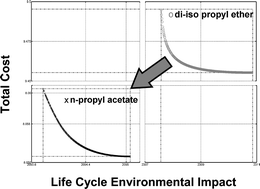Environmental impact minimization through material substitution: a multi-objective optimization approach
Abstract
In this paper, we present a process design methodology for identifying opportunities where step-change improvements in both process economics and environmental impact can be achieved. In particular, the use of computer aided molecular design techniques is proposed as a method for identifying alternative processing materials that can lead to improved designs. Fundamental to the overall approach is the formulation of environmental performance objectives to drive the process design decisions. For this task, a recently developed method of damage modelling for life cycle impact assessment is used to derive an explicit environmental performance metric. Trying to give consideration to not only the traditional financial objectives, but also the multiple environmental concerns, inevitably results in the process design task being formulated as a multi-criteria decision-making process. Using multi-objective optimization techniques, a set of alternative trade-off designs is established that reflect the conflict between the economic and environmental concerns. Accepting that this inherent conflict exists, whereby one objective can not be improved without sacrificing another, the next task is to modify the process through the use of alternative materials in search of superior designs. Focussing specifically on liquid–liquid extraction operations, extensions to our previously developed methodology for designing solvents that are both environmentally benign and cost effective are presented as part of the overall methodology.


 Please wait while we load your content...
Please wait while we load your content...